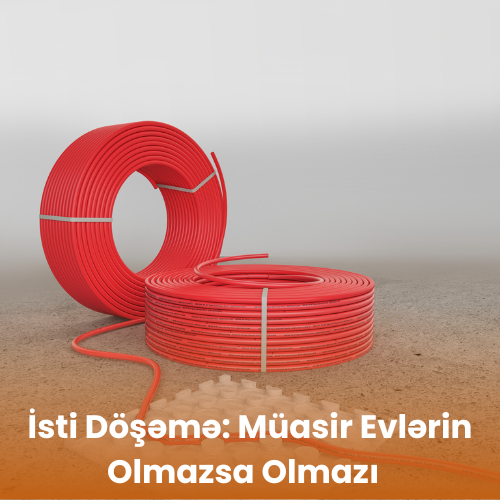Heated Floors: A Must-Have for Modern Homes

What is Underfloor Heating?
Underfloor heating is a heating system installed beneath the floor surface in homes or offices. This system heats the floor, allowing the warmth to rise evenly from the bottom up throughout the room.
Unlike traditional radiators, underfloor heating provides comfortable and natural warmth without creating air circulation in the room. It is both a comfortable and energy-efficient heating method.
Types of Underfloor Heating Systems
Underfloor heating systems are mainly divided into two types:
1. Water-Based Underfloor Heating System
In this system, special plastic or metal pipes are installed under the floor. Hot water from a central heating system or a boiler circulates through these pipes, heating the floor.
Advantages:
-
Ideal for large areas
-
Energy-efficient
-
Provides evenly distributed heating
Areas of Use:
-
Villas
-
Houses and cottages
-
Commercial properties and large spaces
2. Electric Underfloor Heating System
In this system, heating cables, heating mats, or heating films are installed under the floor. The floor is heated using electricity.
Advantages:
-
Easy to install
-
Suitable for small areas
-
Provides fast heating whenever needed
Areas of Use:
-
Apartments
-
Bathrooms
-
Kitchens
-
Balconies
-
Offices
Advantages of Underfloor Heating Systems
Underfloor heating systems have become one of the most preferred heating methods in recent years due to the comfort and benefits they provide.
Main Benefits of Underfloor Heating:
1. Comfort and Convenience
-
Your feet are always warm.
-
Heat is distributed evenly throughout the room.
-
Heating from the floor feels more natural and healthy.
2. Aesthetic Appearance
-
No visible heating equipment like radiators, fireplaces, or air conditioners.
-
Saves space and provides design freedom in the interior of the house.
3. Energy Saving
-
Even at lower temperatures, underfloor heating provides sufficient warmth.
-
This helps save on gas and electricity costs.
4. Health Benefits
-
Minimizes dust circulation.
-
Does not dry out the air and helps prevent allergic problems.
5. Durability and Long Lifespan
-
A high-quality underfloor heating system can work without problems for many years.
-
Requires very little maintenance.
6. Suitable for Any Area
-
Can be installed in any space such as bathrooms, kitchens, children's rooms, bedrooms, living rooms, offices, etc.
How is Underfloor Heating Installed?
Underfloor heating installation is carried out in specific stages by professional technicians. Proper installation ensures the system operates efficiently and lasts long.
Installation Steps:
1. Preparation Stage
-
The floor is completely cleaned and leveled.
-
A project is prepared to determine which rooms will have underfloor heating, the total area, and the type of system to be installed.
-
Necessary materials and equipment are prepared.
2. Thermal Insulation
-
Special thermal insulation materials (such as foam panels) are laid on the floor.
-
This ensures that the heat from the underfloor heating system is directed upwards into the room, not downwards.
3. Laying Pipes or Cables
Depending on the system type:
-
For water-based systems, pipes are laid in spiral or loop shapes.
-
For electric systems, heating cables, mats, or films are installed.
4. System Testing
-
Pipes are tested with water pressure.
-
The electric system is tested with power to ensure everything is functioning properly.
5. Screeding (Concrete Layering)
-
The system is covered with a special concrete screed.
-
After the concrete dries, the floor is ready.
6. Floor Covering
-
Finally, tiles, laminate, parquet, or any other desired floor covering material is applied.
7. System Activation
-
Once all stages are completed, the underfloor heating system is turned on and ready for use.
Frequently Asked Questions About Underfloor Heating
How much energy does underfloor heating consume?
Underfloor heating generally consumes less energy compared to other heating methods because the heat is distributed evenly in the room, reducing the need for high temperatures.
Is underfloor heating safe?
Yes, if installed correctly, underfloor heating is completely safe. The materials and systems used comply with international standards.
What are the benefits of underfloor heating?
-
Warm feet
-
Even heat distribution in the room
-
Aesthetic appearance
-
Energy saving
-
Health-friendly
In which rooms can underfloor heating be installed?
Underfloor heating can be installed in any area, such as:
-
Bathroom
-
Kitchen
-
Children's room
-
Bedroom
-
Living room
-
Office and commercial properties
How long does it take to install underfloor heating?
Depending on the size of the area, installation can take 1-3 days. Additionally, the concrete screed requires 10-15 days to fully dry.
What floor materials are suitable for underfloor heating?
Underfloor heating is compatible with the following materials:
-
Tiles (ceramic or porcelain)
-
Laminate
-
Parquet
-
Vinyl
-
Granite
